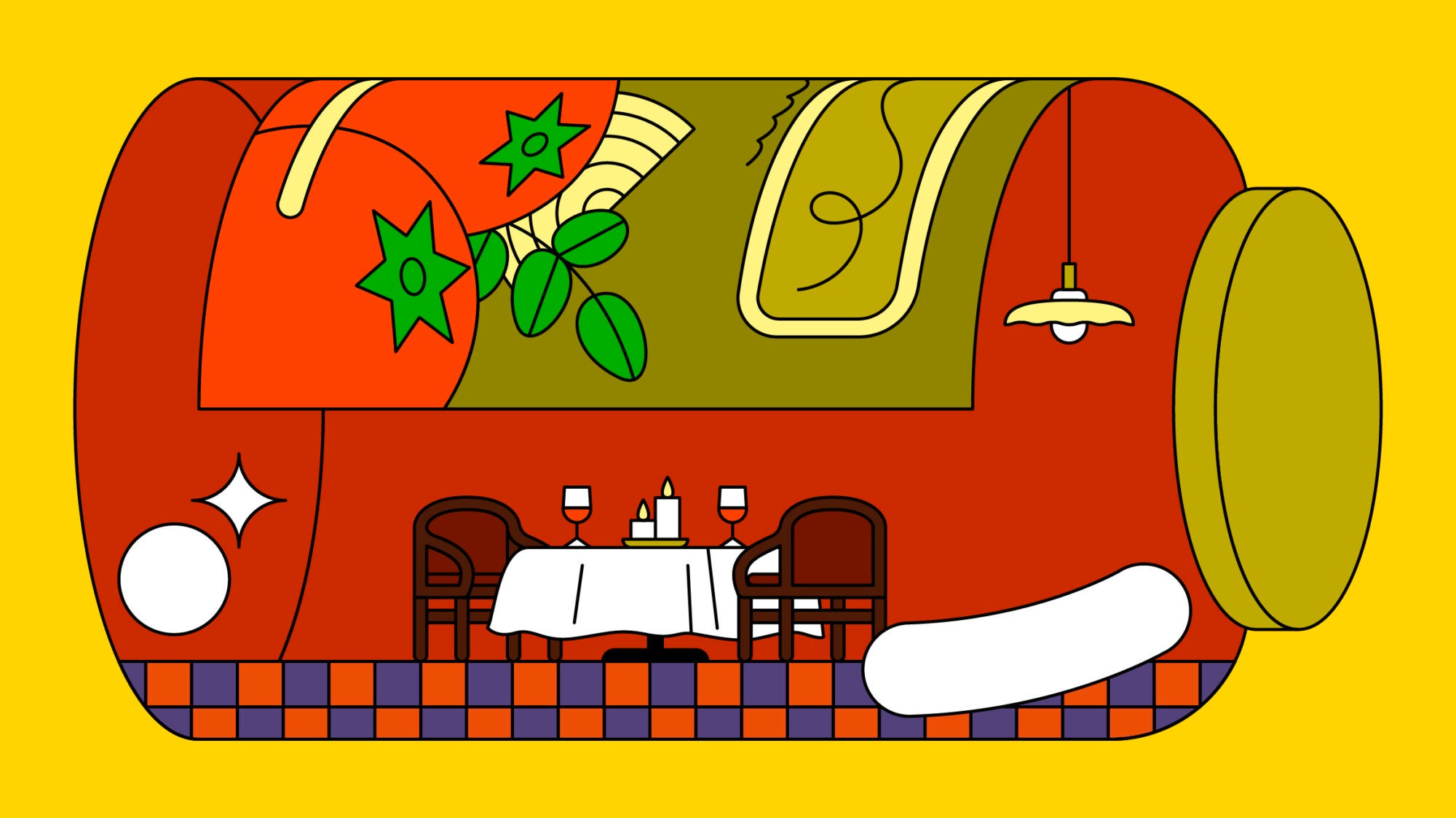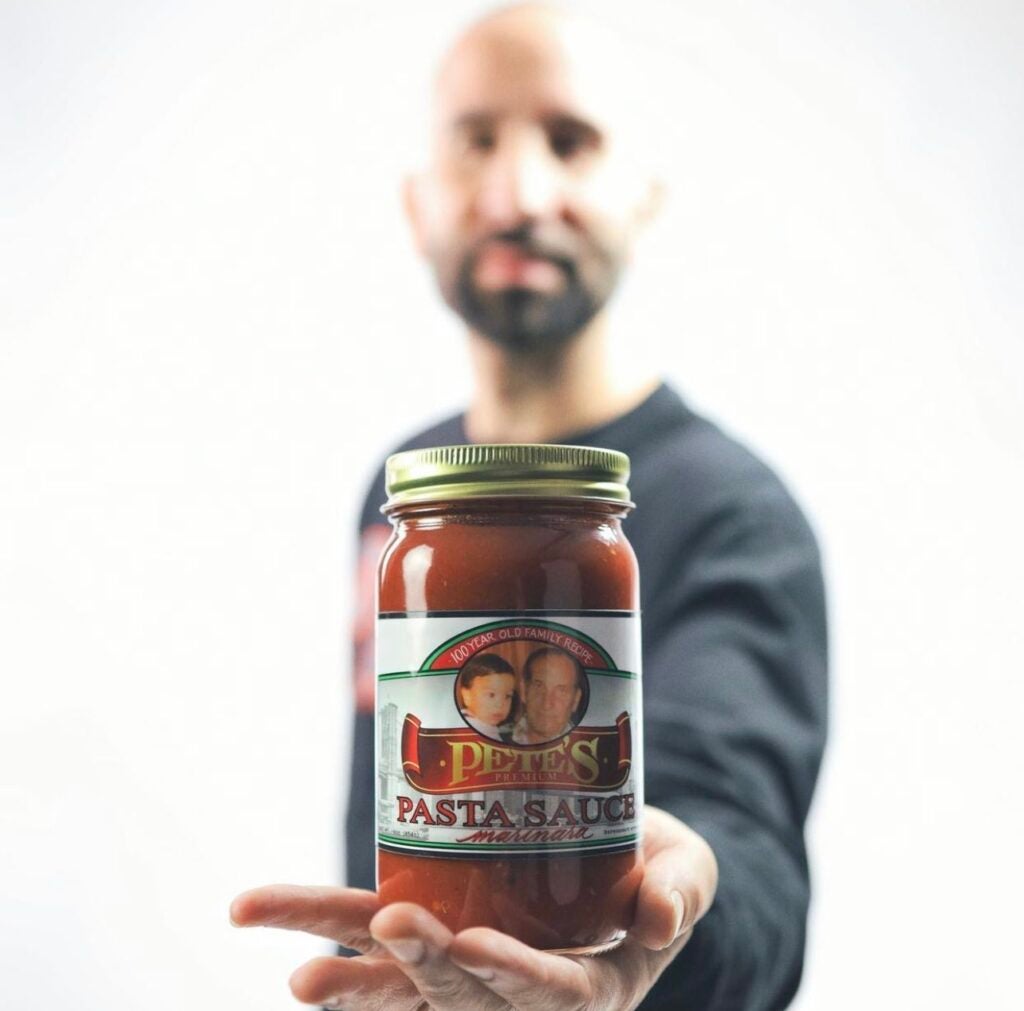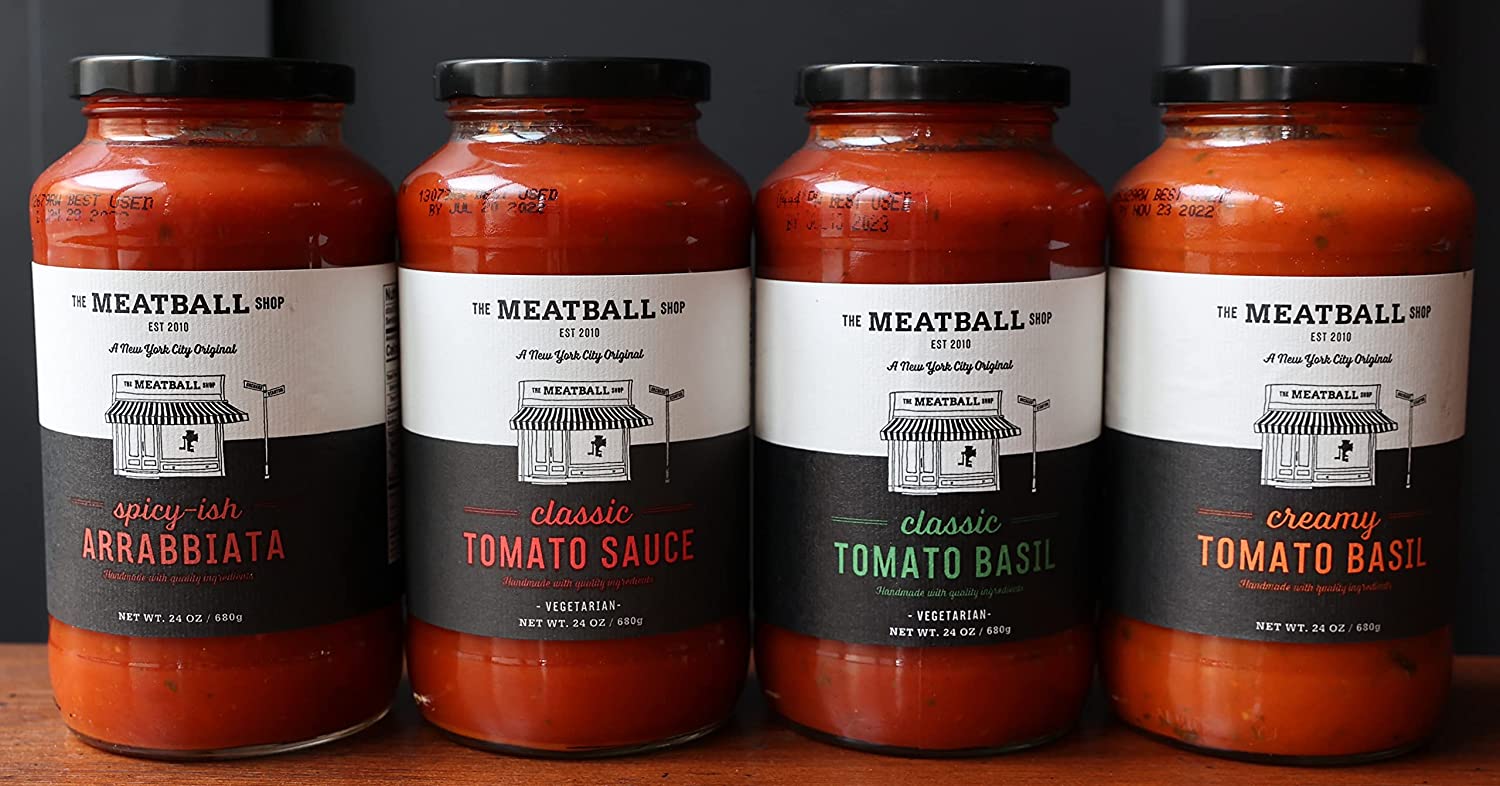
One man’s journey to understanding the draw of Carbone in a can. Well, a jar.
I’ve often found that my appreciation for a store-bought jar of pasta sauce can be considered slightly controversial. “Just make your own,” my friends who are most likely to go full Dan Barber when setting up a dinner party will scold me, condemning me for spending my time making something they’ll say is better because it’s “fresh”—as if I don’t do that already. And yes, when I’ve got a little more time, I’ll crack open a can of Central California and Napoli peeled tomatoes—instantly defeating the idea of freshness, by the way, as if I’ve got vines of ripened tomatoes at my disposal all year in New York. I’ll crush them with my hands, add in the oil and garlic and some (never too many) onions, then wait to toss some basil in there. But I’m only human. I don’t always have the extra minutes to spare.
There’s the time issue, and there’s the deeper, more personal one. I was a latchkey kid growing up in the early 1990s, so there’s some Charles Foster Kane Rosebud impulse in my head that I can’t undo. Unlike Stouffer’s French Bread Pizza or other frozen dinners I could heat up in the oven or microwave, I used the actual stove to boil water for boxes of dry spaghetti and warm up jars of the “Traditional Spaghetti Sauce” flavor Ragú, with its heavy hit of dehydrated onion and garlic powder giving a little life to the watery tomato mush, learning my way around the kitchen as a 10-year old. I’ve since moved on from the starter sauce. My tastes and cooking skills have evolved, but I still love a nice jar of pasta sauce.
I’m not Italian, and I didn’t have many homemade meals as a kid. I still have a taste for the frozen pizzas of my youth from time to time, and I’m a sucker a basic peanut-butter-and-grape-flavor-jelly sandwich on squishy white bread. Those things still generally taste the same as they did when I was a kid. Yet when I’m feeling lazy and just want some spaghetti and sauce right away without the chopping and waiting, I always have a jar of marinara sauce in my cabinet. So, is there something wrong with me liking jarred sauce? Am I committing a slight against the Italian American community and food lovers everywhere?
“No,” Peter Gibaldi, better known as Premium Pete, tells me. I asked him because he’s a guy who does a lot of things that would classify him as an expert on whether or not I should be barred from ever stepping foot in Brooklyn’s Bamonte’s again because I always have a jar of marinara sauce in my cabinet. He has his own—very good—jarred sauce company, which I recognize is a little biased, but I also got to know him because he helps organize MobMovieCon. Those are all the bona fides I need.
“How do you expect people to have this stuff all over the world? I’ve had [orders from] Switzerland, Germany, Tokyo, places I can’t even pronounce. They pay $16, $70, $80 shipping because when they open it up, they get the homemade smell.”
Gibaldi tells me his main motivation behind Pete’s Premium Pasta Sauce isn’t about making money so much as it is about ensuring his family legacy and the recipe he got from his grandparents is out there. The vibrant, garlic-leaning sauce (there are no onions in Pete’s recipe, which is a noticeable subtraction that I appreciate) is part of a bigger story that stretches back to Sicily, before his ancestors immigrated across the ocean. And, to be honest, this is the only one that I keep in my cabinet that isn’t from a restaurant. It actually tastes like tomatoes, garlic, and herbs, not like something that’s been sitting in a warehouse and not like a version of those flavors that was scientifically created by some method I don’t care to understand.
That’s my one big Jarred Sauce Rule. While Pete got me hooked on his stuff, but I like to switch things up. The issue for me, where a little bit of jarred sauce snobbishness comes in, is that if I buy jarred sauce from anyone else, it’s always got to be from a restaurant. After years of mediocre (and some good) jarred sauce, I started to realize that if an established restaurant was going to jar their recipe and sell it to the public, the stuff had to be good. And so far that logic has never steered me wrong. There are plenty of other sauces I’d like to try, but restaurant sauces are usually the safest bet.
My rule of thumb is to either buy from a place that I’ve been to (like Carbone, Michael’s of Brooklyn, or Monte’s—which seems to no longer be operating, but the sauce is still, mercifully, available) or from places that I dream of someday being invited to, specifically Rao’s, that East Harlem institution that’s impossible to get into unless you “know a guy.”. I know my fair share of people, but no movers, shakers, celebrities, or goodfellas who have had the in-demand ables assigned to them by the owners since the late 1970s. You can’t just go on Resy and put your name in. The closest many of us will get to tasting Rao’s food is the humble jar of sauce you buy from the market.
A recent addition to my rotation is the marinara from New York’s Rubirosa. It’s a zesty but balanced sauce. Some places rely on a lot of garlic or they’re a little heavy-handed on the herbs, and sometimes I’m fine with that. But Rubirosa isn’t too much of anything. It’s a perfect sauce for a simple plate of spaghetti and meatballs or if I’m doing something like an eggplant parmesan. Dip a piece of bread in it as it heats up, and it’s delicious on its own (note: I have been known to eat an entire loaf of bread with a jar of pasta sauce), but when added to a dish, Rubirosa’s marinara sauce knows its role.
You don’t have to over-sauce your lasagna or chicken and pasta dish—but you can if you want to. Toss some hot pepper flakes or cheese on top, or don’t. The sauce has enough flavor, and it works well together with whatever meat and—most important—carbs it’s put in a bowl or on a plate with. Sauce should be part of the show, not the entire thing. If you’re familiar with a good jar of marinara or vodka or even pizza sauce, it will always be there when it’s what you want. You don’t have to go to Rubirosa or beg and plead for a reservation at Rao’s or Carbone. You just do it at home.
That’s really the big dividing line between good and bad jarred pasta. It’s not homemade, but you want it to taste as close to homemade as possible. You want it to taste like the ingredients on the bottle; you don’t want it to taste like something that’s been sitting in a box. You want something that will transport you to Sicily or some spot in Little Italy but that also makes you feel at home, because that’s likely where you’re at. The people that make and sell the sauce know that. For Bari Musacchio, a partner in Rubirosa with the Pappalardo family from Joe and Pat’s in Staten Island, it took a lot of convincing before she could feel comfortable jarring her sauce and then putting her restaurant’s name on it. The research and development part took a long time. “I tasted a ton of jarred sauces before entering this to even see if we could capture the essence of the restaurant,” she says. “We had to find a way that, when you cracked it open, whether it’s been sitting in there for six days or six months, it still had this super fresh and alive feeling to it.”
Putting your name on a label is good for business. For some, it’s monetary—look at the countless celebrities rushing to start their own tequila or whiskey brands—while others see a product as a way to put their name out there more. Musacchio’s reason for jarring Rubirosa’s sauce is a pragmatic one. “Fortunately, after 13 years, we’re still very busy. We’re booked all the time and have waiting lists,” she says of her single Manhattan location. Rubirosa works as a restaurant because the food is good, but it isn’t huge and forbidding. With 70 seats, it isn’t small, but it isn’t exactly large, either. Getting reservations there isn’t always easy, and that factored into the idea behind the sauce. “So we’re like, ‘Okay, how else can this brand grow?’ Let’s find a way for people to be able to enjoy things from the restaurant in their house, an extension of it in another accessible way for people to experience the brand since it’s a tiny space.”
For Daniel Holzman, opening the first Meatball Shop location in 2010 with his partner, Michael Chernow, came with all the headaches and quagmires that accompany a new restaurant. But for Holzman, the restaurant’s foundational sauce became his big focus. Chernow was working at Frank in the East Village while the pair were getting ready to open. Holzman was obsessed with his partner’s rigatoni made with a special meat gravy.
“They probably put a handful of cheese, you know, the size of your head in there,” Holzman jokes. That was a big influence for Holzman, but he didn’t want to carbon copy Chernow’s employer, because that’s missing the point of a sauce. It has to be your thing, not Frank’s or somebody else’s. So they got to work, and as Holzman recalls, the process was similar to an athlete practicing the same shot over and over—the slightest tweak of the body here to add a little more power or a little more finesse, less garlic or more, an extra sprinkle of oregano, or maybe you get basil from a different farmer. “Mike would always bust my chops because the sauce was never right,” Holzman admits. A big reason for that was because he was working from memory, trying to do something akin to a sauce he’d tasted but not exactly like it. “We probably put more time into the tomato sauce than we put into the meatballs themselves,” he says.
The thing about opening a place and calling it the Meatball Shop is that the balls of meat instantly become the focus of the business. The Meatball Shop was an instant hit, but something funny happened. The sauce that Holzman was so focused on perfecting became a hit with diners and food bloggers. You can find more than a few 2010 and 2011 reviews of the restaurant or home cooks from miles away trying to replicate the flavors that focus a lot of attention on the sauce. The sauce got so popular that, in 2016, the partners started searching for a company that could take the recipe and put it in a jar, so that the person who opened the lid would get as close as possible to eating a meal at the Meatball Shop without having to set foot in there.
Things worked out so well that Holzman even started using the tomatoes they found for the jarred version in the house sauce. The jarred sauce influenced the original restaurant recipe. Today, the Meatball Shop works with a canner in Red Wing, Minnesota, “where they make the boots,” Holzman tells me. “So I’m always compelled to buy a pair when I go there.” He adds that the canners are “pretty special guys.”
One of the big problems with jarred sauce is likely the same with anything that’s premade, packed, and given a label before it’s shipped off to grocery stores: It doesn’t feel real or authentic. I’ve heard some people describe the sauce as the “soul” of Italian food, and the idea that there’s something deep and real in food made by somebody in their kitchen for you is the prerequisite for assigning spirit to a dish.
You want something that will transport you to Sicily or some spot in Little Italy
It’s not an ingredient that’s missing (although I have been known to describe plenty of tomatoes or heads of garlic as “soulless”), but it’s not somebody that looks like Martin Scorsese’s mom in Goodfellas making it for you from scratch, and it’s not straight from the pot to the white-cloth-covered table of some red sauce place that’s been around for over a century. The jarred sauce you buy from a grocery store or restaurant is almost always produced en masse, with stabilization of water to help keep the product fresh that takes some science and mechanics. It’s not some cute old grandma dipping a wooden spoon in each pot and going, “Needs more salt”; there is a touch of the old Henry Ford production line feel to it. But ultimately, if the sauce is going to be good, there has to be that ingredient that you can’t see or measure.
You could employ the corny cliché that there has to be love in it, but it’s the obsessiveness of the person putting their name or their business’s name on the label that makes each different jarred pasta stand out from the one that might sit next to it on a grocery store shelf. What is that little thing that the person behind the sauce likes? A certain texture? Perhaps they like a little more basil than the next guy? Whatever it is, the sauce is an extension of that person and their business that you bring into your home, and I thought about that recently as I found myself facing down a midnight craving for the leftover veal parmesan I’d brought home from Carbone.
The famous Thompson Street hot spot with brand extensions in Las Vegas, Miami, Hong Kong, and Saudi Arabia is known for being one of the hardest reservations to score. And while the spicy rigatoni, cooked to a perfect shade of orange, that pops hard on Instagram is the dish everybody tells you to get, the veal parm is ridiculous—almost subtle for a dish that’s actually pretty decadent. It’s not too heavy, and it’s crispy without being overly breaded. Beautiful, but also not overflowing in sauce—which parm is more often than not.
And while I was perfectly happy eating it that way when it was served straight from the kitchen at the restaurant, the microwave reheat just never hits the same. There’s a dryness to it that needs a nice oomph. Thankfully, when a 2 a.m. craving hit for my leftovers, I remembered that in my cabinet was a jar of Carbone marinara sauce that I’d purchased a week earlier for this article. I cracked it open, poured it in a little saucepan on my stove, waited a minute or two, and placed the leftover parm on a roll that the server at Carbone gifted me along with my leftovers.
He likely knew what I planned to do: pour the sauce in a little dish and dip my sandwich with each bite. As I was about to finish, my wife—one of those people who does not share my appreciation for glass jars filled with marinara or vodka sauce—walked in the kitchen, catching me in the act. She looked at me, shook her head, and said, “Jarred sauce saves the day.” Then she turned around and went back to bed. Another happy memory associated with a jar of pasta sauce purchased from the grocery store.

